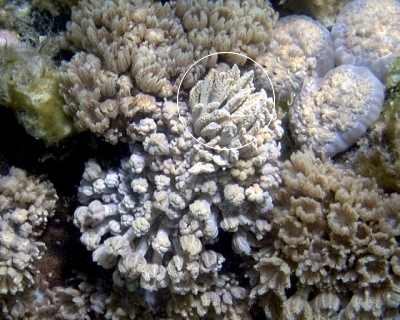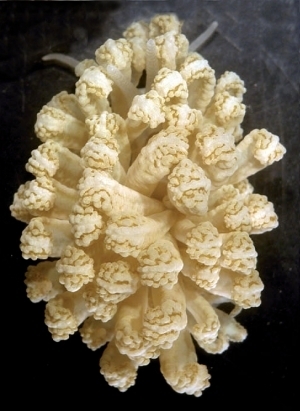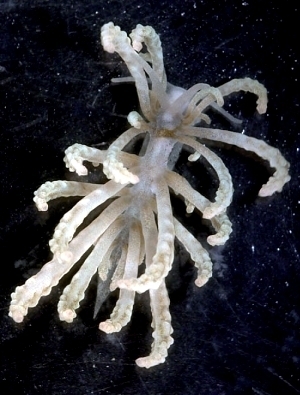
Phyllodesmium lizardensis
Burghardt, Schroedl & Wagele, 2008
Order: NUDIBRANCHIA
Suborder: AEOLIDINA
Family: Glaucidae
DISTRIBUTION
Known from Lizard Island, Great Barrier Reef. Australia.
PHOTO
Upper right: Phyllodesmium lizardensis nestled in xeniid coral colony. Lower left: resting animal with ceratal tips rolled over to mimic xeniid tentacles and perhaps to present symbiotic zooxanthellae to sun light. Lower right: Moving animal with cerata fully extended. This specimen has about half the cerata of the resting animal suggesting many have been autotomised. Photos: Ingo Burghardt.
The body, including oral tentacles, rhinophores, and foot, is translucent white, with the opaque white internal organs showing through the body wall. The right branch of the digestive gland, just behind the rhinophores, shows through as a brown line.The cerata are an opaque to creamish white, with patches of yellow brown between the opaque white ridges and pustules. Animals grow to approximately 45mm in length. The rhinophores and oral tentacles are both smooth and tapering, and the anterior corners of the foot and formed into slightly rounded extensions.
When fully extended some cerata are almost as long as the body, but others are much shorter. The number of cerata vary amongst specimens, which suggests that they are often autotomised, and regrown. The cerata (up to 50) are arranged up to five, mainly incomplete, arches on each side of the body. The raised anal papilla is situated within the second ceratal arch on the right side. The bottom half of the cerata forms a cylindrical stalk while the upper half is more flattened, with rounded pustules along each edge and a rounded ridge up the ventral midline. When at rest the cerata are slightly contracted and the flat upper half curl inwards so that rounded median ridge on the ‘ventral’ surface and the lateral pustules form a pattern mimicking the tentacles of their xeniid host. When disturbed, and/or preserved, nearly all cerata were autotomised. The radular ribbon consists of a single central row of elongate teeth each with 36-38 short denticles on each side, very similar to that of P. hyalinum and P. crypticum. There is a central narrow digestive gland duct extending into each ceras, which gives of secondary and tertiary branches which radiate out towards those parts of the ceratal wall which are exposed to light. Zooxanthellae are present in digestive gland branches.
Known at present only from Lizard Island, GBR in depths between 0.3 and 1 m. Numerous specimens were found always nestled inside large colonies of xeniid corals. When sitting on the soft coral, the bodies of the slugs were not visible, only the cerata extended slightly beyond the tentacles of the corals. The cerata mimic the xeniid tentacles in colour and shape.
Phyllodesmium lizardensis is similar in shape to two other xeniid feeders, P. hyalinum and P. crypticum. It is most similar to P. crypticum in ceratal shape and in the position of the anal opening, but the two can be separated by several differences - the anterior foot corners of P. lizardensis form only slightly rounded extensions, whereas P. crypticum has distinct tentacular processes. The cerata of P. lizardensis have a basal half which forms cylindrical stalk while the upper half is dorsoventrally flattened and covered by irregularly shaped lateral pustules and a median rounded ridge. The cerata of P. crypticum are quadrangular in cross section along the whole length and covered with nodules that are mainly arranged in rows, especially along the edges.
-
Burghardt, I., Schroedl, M. & Wagele, H. 2008. Three new solar-powered species of the genus Phyllodesmium Ehrenberg, 1831 (Mollusca: Nudibranchia: Aeolidioidea) from the tropical Indo-pacific, with analysis of their photosynthetic activity and notes on biology. Journal of Molluscan Studies, 74: 277-292.


Rudman, W.B., 2008 (August 29) Phyllodesmium lizardensis Burghardt, Schroedl & Wagele, 2008. [In] Sea Slug Forum. Australian Museum, Sydney. Available from http://www.seaslugforum.net/factsheet/phyllodliza
